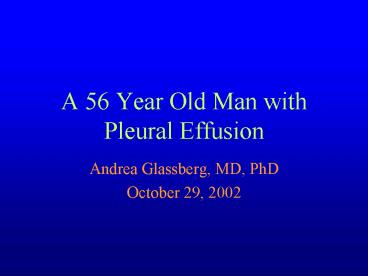A 56 Year Old Man with Pleural Effusion PowerPoint PPT Presentation
1 / 29
Title: A 56 Year Old Man with Pleural Effusion
1
A 56 Year Old Man with Pleural Effusion
- Andrea Glassberg, MD, PhD
- October 29, 2002
2
Case Presentation
- A 56 year old man presented to the emergency
department complaining of pleuritic chest pain
and dyspnea on exertion. - Three weeks prior to admission he developed left
sided pleuritic chest pain, subjective fevers,
chills, lightheadedness, and night sweats. He
denied cough, wheezing or sputum production. One
week prior to admission he noted dyspnea on
exertion.
3
Past Medical History
- Erosive arthritis (presumed to be RA)
- Spinal compression fractures (due to prednisone)
- Depression
- Chronic Pain
4
Physical Exam
- Emaciated middle aged WM, NAD.
- 98.4, 103/61, HR 69, RR 18, O2 sat 98RA
- No lymphadenopathy
- Slightly decreased BS left lower lung field
- Decreased tactile fremitus left base
- Single rheumatoid nodule left 3rd toe
5
Labs
- WBC 10.5 (8.18N)
- HCT 38
- PLT 254
- Na 137
- LFTs WNL
- Protein 6.2
- INR 1.0
- Troponin-I negative
- LDH 119
- RF
6
Additional Information?
7
(No Transcript)
8
(No Transcript)
9
(No Transcript)
10
Pleural Fluid
- Yellow, hazy
- WBC 14000
- RBC 1900
- 70 neut
- 14 eos
- 1 meso
- 5 lymph
- Protein 4.5
- Glucose 102
- LDH 266
- Amylase 42
- Chol 84
- ADA 4.3 (1.6 to 9.2)
11
Pleural Fluid
- Gram stain negative
- Culture negative
- AFB negative
- Cytology benign
12
Differential Diagnosis of Pleural Fluid
Eosinophilia
- Air in pleural space
- Hemorrhage
- PE
- BAPE
- Infection
- Parasitic
- Fungal
- Idiopathic
13
DDx in this patient
- Malignancy
- Infection
- TB
- Parapneumonic effusion
- PCP
- Parasitic
- Fungal
- RA
- Drug Reaction
- PE with infarction
- Post Traumatic
- Benign Asbestos Pleural Effusion
14
Additional Information?
15
What would you do next?
16
VATS
- Pleural fibrosis.
- No granulomas.
- No asbestos bodies or fibers
- No evidence of vasculitis or tumor.
- Cultures negative.
- Stains for AFB and fungi negative.
17
(No Transcript)
18
(No Transcript)
19
What does this patient have?
20
What is the next step?
21
BAPE
- Benign Asbestos Pleural Effusion
22
BAPE What is it?
- Initially described 1950s.
- Most common pleuro-pulmonary asbestos related
abnormality during the first 20 yrs after
exposure. - Exudative pleural effusion.
- Exposure to asbestos.
- Exclusion of other causes of effusion.
- Exclusion of malignancy for two years of follow
up.
23
BAPE, Pathogenesis
- Exact mechanism unknown
- Hypothesized that submicroscopic asbestos
particles in the pleural space induce a constant
stimulation to pleural mesothelial cells to
release chemotactic factors
24
BAPE Who gets it?
- Reported to occur in 3 of asbestos exposed
workers. - Latency period shorter than for other asbestos
related disorders, ranges from 1 to 58 years,
mean of 20 to 30 years. - Prevalence dose related with 7.0 direct
exposure, 3.7 indirect, and 0.2 peripheral.
25
BAPE How does it present?
- 50 or more may be asymptomatic.
- Most common symptom is chest pain.
- Fever
- Cough
- Dyspnea
26
BAPE, Characteristics
- Small to moderate sized effusion
- 10 bilateral
- Often recurrent
- Pleural plaques common
- Pleural calcifications uncommon
27
BAPE, Fluid Characteristics
- Exudative
- WBC usually lt6000/mm3 but can be as high as
28,000 - Neutrophil or mononuclear predominance
- Mesothelial cells
- Eosinophilia
- No asbestos bodies or fibers
28
BAPE, Sequelae
- Effusions last 1-10 months, median 3 mo.
- 28 recurrent, often contralateral.
- Pleural fibrosis
- Malignant mesothelioma (5 in one series of 61
patients occurring 6, 9, and 16 years after the
initial effusion)
29
References
- Epler, GR, McLoud, TC, Gaensler, EA. Prevalence
and incidence of benign asbestos pleural effusion
in a working population. JAMA 1982 247617. - Hillerdal, G, Ozesmi, M. Benign asbestos pleural
effusion 73 exudates in 60 patients. Eur J
Respir Dis 1987 71113. - Light, RW. Pleural Diseases, 3rd ed. 1995.
- UpToDate version 10.2, Pleural fluid
eosinophilia. - UpToDate version 10.2, Diagnostic evaluation of a
pleural effusion. - UpToDate version 10.2, Pulmonary pearls A 47
year old man with left chest pain, dyspnea, and
an eosinophilic pleural effusion.

